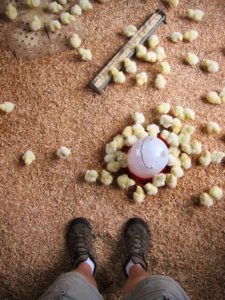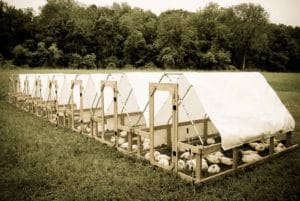Mail Order Chicks
First steps to caring for your new brood.
Whether your farm is large or small scale there is usually one guiding motivator that we all share: fostering life. There are few things more exhilarating on a farm than new buds breaking through the surface of the soil, the first steps of a new born calf, or knowing your customers are happy and healthy eating the food that you provided.
In poultry farming that new life can come in two ways. You can have an incubator on farm and hatch your own eggs, or you can order chicks through a hatchery. Order chicks? Like, in the mail? That’s right.

The placement of the chicks is a clue to much heat the brooder lamp is putting out. Photos by John Suscovich
You see, at the writing of this article I do not have an incubator or hatching program on my farm. I order all of my chicks in. In fact, I am getting 100 egg layers tomorrow morning, and today I just placed 10 orders for the summer totaling in 2400 broilers. I’ve been doing this for a while now and I have had a lot of chicks come in the mail. There are a few things you should know when ordering chicks to come in the mail, let’s go over a few.
The first step applies to any agricultural operation.
Do your research.
You want to know what you are doing before you are caring for babies. That’s what they are, chicken babies. You will not only want to know everything you can about how to raise the chicks, but also where to order them, which hatchery to trust, and how to handle the chicks when they arrive on your farm. I highly recommend Robert Plamondon’s “Success With Baby Chicks” as a good book to own if you want to raise chickens from chicks. It is an honest and down to earth “how to” book that doesn’t leave you feeling like everything you do is going to kill your chickens.
The chicks are going to be fine.
Baby chicks can survive roughly 3 days with what’s left of the yolk in its stomach after it hatches. Hatcheries hatch the chicks and have them in the mail very quickly headed toward your local post office.
There are minimum orders for a reason. The number of chicks huddled together help regulate temperature and keep each other warm. Chicks should never be allowed to get chilled – not until they are older and can regulate their body temperatures.
There are times where shipping is delayed for some reason, or something goes wrong. Mortality can happen in transit. If you have very sensitive kids I’d open the box without them seeing, or be prepared for a pretty serious discussion.
Baby your babies.
I go back to doing your research and knowing what you are doing. That is crucial. I’ll give you the general over-view of what I do, but there are some specifics that are a little detailed for the length of this article.
Before the chicks arrive I prepare my brooder space. I make sure all the lamps are working, I have fresh pine shavings, I have feed, the proper waterers, and the area is secure against predators that may come lurking in the night. There are different schools of thought as to whether chickens will eat the pine shavings and choke when they’re young. I have started a lot of chickens on pine shavings and haven’t had that problem yet.
When the chicks arrive, temperature is my main concern. They want to be at 95 degrees when they are very young. They’re supposed to have a mother hen sitting on them, so you need to take the place of that environment. I control the heat in my car on the way to the farm. Once there I minimize the time they are outside, especially if it is cold outside. From there I make sure the brooder is on and warmed up.
When I take the chicks out of the box I dip their beaks in warm water and make sure feeders are close by. I also put a little bit of feed on a piece of board so they can scratch around. Some people don’t put food in right away and wait up to three hours to give the birds a chance to rehydrate. I do both at once and haven’t found issue yet.
From then on out I check in on them several times a day making sure they aren’t getting stuck anywhere, piling up, and I keep them with fresh water. Something to look for in regards to the heat that your brooder lamp is putting out is the placement of the chicks. If the chicks are all huddled in a mass under the light and they are climbing on top of each other than your light is too high and the birds are cold. If your chicks are in a ring around your light without any birds in the middle your light is too close and they birds are too hot. This also poses a fire hazard, so be careful. You should be checking in several times a day, especially for the first week, so it will quickly become obvious what normal behavior is.
Know when to bring the birds outside.
Too much time in the brooder isn’t a good thing. As the birds grow they are going to need more space. I raise birds on pasture, so when they are big enough they go in my mobile coops or chicken tractors. For my meat birds they are in the brooder about three weeks in the colder months and less in the summer if they feather out. For egg birds it takes a couple weeks longer than that. You want the birds to have a good covering of feathers to ensure they can protect themselves from the elements.
It helps to be able to brood the chicks in an area where you can give them access to the outdoors to acclimate them before they take the plunge into pasture life. My brooder has doors that open and fenced off areas when I have grass and feed hay. On that note, I put two things in with my chicks that I seldom see anyone else do. Total transparency:, I got this idea from Troy Bishopp, aka “The Grass Whisperer”. The first is a pile of grass or hay. If these birds are bound for life on pasture why not start by bringing the pasture to them? It gives them something to do, adapts them to eating grass, and adds nutrients. The second thing is a shovel full of dirt. That’s right, dirt. They will devour that pile of dirt looking for small stones to aid digestion and whatever else may be in there. I’ve seen batches of chicks completely devour a spade full of dirt in a 24 hour period. You could always pay for the stones that the hatchery tries to sell you, or you could go the free route and do just fine.
In the end you just have to enjoy it. That peeping that comes home with you in the car is very cute for the first ten minutes. Kids love baby chicks, it is rewarding to care for them and watch them grow (kids and chicks), and some day they will provide you with the food that is going to keep you happy and healthy.


